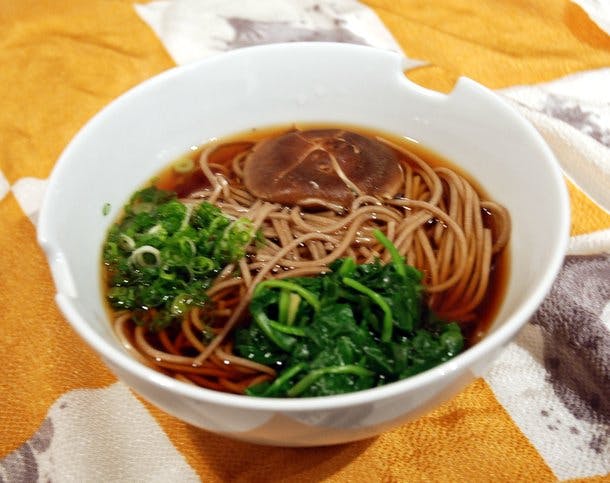
soba noodles in duck broth
Learn how to make a rich and flavorful duck soba tsuyu, a Japanese soup for soba noodles, from Chef Ono's traditional cooking method. This recipe includes preparing duck stock, making kaeshi, cooking soba noodles, and assembling the dish with garnishes. Discover the layers of flavor and aroma that make this soup the perfect antidote to a blustery winter day.
Watching a cook named Adam swiftly and deftly portion a duck the other night at Matsuri, I posited, out loud, that the beautiful, gleaming carcass -- all that was left after Adam's handiwork - would make for an excellent soup stock. Chef Ono heard me and walked over. "Those duck bones would make a great soba tsuyu," he said -- soup for soba noodles. "Take a carcass home and try it." And so I did.
Before I wrapped the bones -- carcass, wings and neck -- and left for the night (and shoved the duck parts into my backpack for the subway ride home -- I wonder what the other passengers would have thought if they knew), I stopped by the chef's office in the back of the kitchen to ask him about the technique. Here's the method Chef Ono described:
First, prepare the duck stock. Begin by adding the bones and cold water to a large stock pot. Bring to a boil over high heat. You'll see a healthy head of scum building up on the top of the surface but don't bother skimming. As soon as the water boils, pull out the bones and dump the contents of the pot. This process washes the bones. Now you're ready to begin cooking the actual stock.
Refill a clean stockpot with water, the washed bones and a few pieces of konbu, kelp. I used four 2-inch-long pieces. (Is that about right or too much? If you have an opinion, please comment! Thanks.) Bring to a boil and then lower to a gentle simmer. Keep an eye on the konbu. As soon as bubbles appear on the surface, remove the konbu from the pot (you can use it to make tsukudani, if you'd like -- fodder for another post). By the way, I've heard this instruction before but had no idea what the bubbles actually look like. I've tried to solve this mystery in the photos below. Okay, back to the soup: Keep simmering the stock for at least an hour, occasionally skimming off any scum that appears on the surface.
While the stock is going, prepare a kaeshi. This is a reduction of mirin and soy sauce to flavor the duck broth. In a saucepan combine one cup mirin with one cup soy sauce and over a moderate heat, slowly boiling until it reduces to a one cup syrup. This took me about an hour -- make sure to take it nice and slow so you don't burn the sugars. Kaeshi, by the way, can sit in the fridge for weeks. Chef Ono told me that it gets better as time goes on, as the flavors combine further.
While the stock is cooking you should prepare garnishes, too. Quickly blanch then shock chopped spinach and boil whole shiitake mushroom caps until they cook through. Thinly slice a green onion. Also, bring another stockpot filled with water to a rolling boil for cooking the noodles.
When the stock is done, as a final step add katsuo bushi, shaved bonito flakes. ("To give it a kick," as the chef said.) Add two cups of katsuo bushi to the stock (what do you think about this portion?), boil for three minutes, then turn off the flame and let it seep for another two minutes. The katsuo bushi will sink to the bottom. Now drain the stock into a colander lined with cheesecloth. Keep the broth, discard the rest. Your broth is ready.
Boil the soba noodles in plenty of boiling water. I used imported dry soba from my local Japanese market. As the soba cooked, I tested it by pulling out noodles, sticking them under cold running water and biting. Soba should be boiled until al dente -- be careful not to overcook. Drain the soba when it's ready and rinse in cold running water.
Now assemble your dish: Prepare the soba tsuyu, the soup, by combining 10 parts broth to one part kaeshi (a measuring cup with Metric marks works great for this). Pour the hot soup in a bowl, add noodles, top with garnish and serve.
The steaming soup had a wonderful aroma and so many layers of flavor, from the essence of the duck to the savoriness of the kelp (umami) to the caramelized sugars of the kaeshi. And the delicious buckwheat soba added toothsome texture. My girlfriend and I sprinkled a little shichimi, chili mixture, and tucked in. The perfect antidote to a blustery winter day.
Note One: You can serve this duck-flavored tsuyu with cold soba noodles, too. Just adjust the proportions to 5 parts broth to one part kaeshi.
Note Two: Try the tsuyu with udon, too. I prepared this dish the next day with imported sanuki udon, which is a thin flour noodle from Shikoku. As an added step, I brought the tsuyu to a boil and poached an egg in the liquid. I poured the hot broth into a bowl, added the noodles and topped with the egg and garnishes. The soft yolk added a layer of richness to the soup and the silky udon was a joy to slurp. Amazing.
Here are photos from my kitchen:
